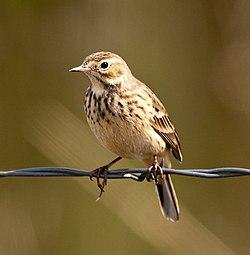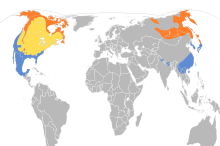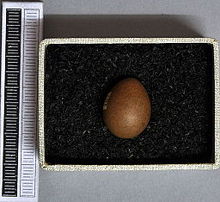Buff-bellied pipit
| Buff-bellied pipit | |
|---|---|
 | |
| Nominate subspecies in Oregon, USA | |
Conservation status | |
 Least Concern (IUCN 3.1)[1] | |
Scientific classification | |
| Kingdom: | Animalia |
| Phylum: | Chordata |
| Class: | Aves |
| Order: | Passeriformes |
| Family: | Motacillidae |
| Genus: | Anthus |
| Species: | A. rubescens |
Binomial name | |
Anthus rubescens (Tunstall, 1771) | |
 | |
Synonyms | |
Anthus pensilvanicus | |
The buff-bellied pipit (Anthus rubescens), or American pipit as it is known in North America, is a small songbird found on both sides of the northern Pacific. It was first described by Marmaduke Tunstall in his 1771 Ornithologia Britannica.[2] It was formerly classified as a form of the water pipit.
Contents
1 Description
2 Taxonomy
3 Behavior
4 Reproduction: from pairing to fledging
5 Status
6 References
7 External links
Description
Like most other pipits, the buff-bellied pipit is an undistinguished-looking species which usually can be seen to run around on the ground. The rubescens subspecies (or American pipit) has lightly streaked grey-brown upperparts and is diffusely streaked below on the buff breast and flanks. The belly is whitish, the bill and legs are dark. The japonicus subspecies (or Japanese pipit) is darker above and has bolder black streaking on its whiter underparts; its legs have a reddish hue.[3][4] The call is a squeaky sip.[4]
Taxonomy
The scientific name is from Latin. Anthus is the name for a small bird of grasslands, and the specific rubescens means "reddish", from
ruber, "ruddy".[5]
It has two distinctive subspecies, but morphological and DNA sequence differences between them are rather pronounced and they might be considered distinct species pending further research:[4][6]
A. r. rubescens - (Tunstall, 1771), American pipit – breeds in northern North America, extending further south in mountainous areas
A. r. japonicus - Temminck & Schlegel, 1847, Japanese pipit or Siberian pipit – breeds in most of eastern temperate Asia (including Japan)
This species is closely related to Eurasian rock pipit (A. petrosus) and water pipit (A. spinoletta), all three forms having previously been considered conspecific. They can be differentiated by their vocalizations and some visual cues, but rock and buff-bellied pipit are not found sympatrically except as vagrant individuals, and the ranges of buff-bellied and water pipits overlap only in a small area in Central Asia.[3][7][8]
Anthus rubescens - Buff-bellied Pipit - XC111042
Behavior
Both subspecies of the buff-bellied pipit are migratory. The buff-bellied pipit winters on the Pacific coast of North America, and on the Atlantic coast from the southern North America to Central America.[1] At least regarding the buff-bellied pipit, its wintering range seems to have expanded northwards in the 20th century and the birds seem to spend less time in winter quarters: in northern Ohio, for example, the species was recorded as "not common" during migration in May and September/October in the 1900s (decade), but today it is considered a "widespread migrant" in that region, found between March and May and from late September to November, with many birds actually wintering this far north. Asian birds winter mainly from Pakistan east to and Southeast Asia, with occasional birds found as far north as Yunnan and some in Japan apparently being all-year residents or migrating but a little. The American and Asian subspecies are rare vagrants to Western and Eastern Europe, respectively.[4][9][10][11]
Like its relatives, this species is insectivorous. The breeding habitat of buff-bellied pipit is tundra, but outside the breeding season it is found in open lightly vegetated areas, similar to those favoured by the water pipit (A. spinoletta).[4]
Reproduction: from pairing to fledging

Egg, Collection Museum Wiesbaden
The first thing buff-bellied pipits do when they arrive on the breeding site, during snowmelt, is pairing. Indeed, males will start to fight one on one to win over the female and pair with it during the entire breeding season. They also fight for the snow-free sites that would be better for nesting. The moment is also very important because the melting snow implies an increase in arthropods abundance, which constitute the main food source for these birds. After the fight and the pairing, nesting is the next step. Nests are most often found on the ground in dry or wet meadows, always with a helpful protection, but they are never placed in shrubs or trees.[12][13] The composition of the ideal nest depends on whatever is around the nesting area, but it is usually made of sedge, remains or new fine grass, and sometimes some horse hairs.[13] The final issue buff-bellied pipits have to deal with is nest success. The nest is indeed the target for numerous predators such as ants or hawks. If this step is successful, an egg can be produced.[13] The female will not lay an egg if the conditions, such as temperature and nesting site, are not optimal. If the first attempt fails, her time to lay an egg is reduced. In general, buff-bellied pipits continuously lay eggs over a period of 4 to 5 days after snow-melt (in April–May) until mid-July. After this period, the male testes decrease in size and the female refuses any copulation.[14] The clutch size is usually 5 eggs but it can vary according to snowfalls, the parents’ reproductive ability and predation.[12] Eggs are incubated for 13–14 days.[14][15] During this time, the female does not leave the nest, but is still very reactive to any movement around her. She communicates by singing to the male that brings her food and defends their territory. Four or five days after hatching, the young is skinny, blue-gray in color, and only has its secondary feathers. For a week, the female will brood the clutch, but both parents will feed them. After these 7 days, the birds are ready for fledging but they will still be fed by their parents for 14 days after their departure. Finally, immature birds will form little flocks with other immature birds and wander off.[13][15]
Status
It is a widespread and common species and not considered threatened by the IUCN.[1]
References
^ abc BirdLife International (2013). "Anthus rubescens". IUCN Red List of Threatened Species. Version 2013.2. International Union for Conservation of Nature. Retrieved 26 November 2013..mw-parser-output cite.citationfont-style:inherit.mw-parser-output .citation qquotes:"""""""'""'".mw-parser-output .citation .cs1-lock-free abackground:url("//upload.wikimedia.org/wikipedia/commons/thumb/6/65/Lock-green.svg/9px-Lock-green.svg.png")no-repeat;background-position:right .1em center.mw-parser-output .citation .cs1-lock-limited a,.mw-parser-output .citation .cs1-lock-registration abackground:url("//upload.wikimedia.org/wikipedia/commons/thumb/d/d6/Lock-gray-alt-2.svg/9px-Lock-gray-alt-2.svg.png")no-repeat;background-position:right .1em center.mw-parser-output .citation .cs1-lock-subscription abackground:url("//upload.wikimedia.org/wikipedia/commons/thumb/a/aa/Lock-red-alt-2.svg/9px-Lock-red-alt-2.svg.png")no-repeat;background-position:right .1em center.mw-parser-output .cs1-subscription,.mw-parser-output .cs1-registrationcolor:#555.mw-parser-output .cs1-subscription span,.mw-parser-output .cs1-registration spanborder-bottom:1px dotted;cursor:help.mw-parser-output .cs1-ws-icon abackground:url("//upload.wikimedia.org/wikipedia/commons/thumb/4/4c/Wikisource-logo.svg/12px-Wikisource-logo.svg.png")no-repeat;background-position:right .1em center.mw-parser-output code.cs1-codecolor:inherit;background:inherit;border:inherit;padding:inherit.mw-parser-output .cs1-hidden-errordisplay:none;font-size:100%.mw-parser-output .cs1-visible-errorfont-size:100%.mw-parser-output .cs1-maintdisplay:none;color:#33aa33;margin-left:0.3em.mw-parser-output .cs1-subscription,.mw-parser-output .cs1-registration,.mw-parser-output .cs1-formatfont-size:95%.mw-parser-output .cs1-kern-left,.mw-parser-output .cs1-kern-wl-leftpadding-left:0.2em.mw-parser-output .cs1-kern-right,.mw-parser-output .cs1-kern-wl-rightpadding-right:0.2em
^ Tunstall, Marmaduke (1771): Ornithologia Britannica: seu Avium omnium Britannicarum tam terrestrium, quam aquaticarum catalogus, sermone Latino, Anglico et Gallico redditus. J. Dixwell. London. [in Latin]
^ ab Alström, Per & Mild, Krister (1996). "The identification of Rock, Water and Buff-bellied Pipits". Alula. 2 (4): 161–175.
^ abcde Svensson, Lars; Zetterström, Dan; Mullarney, Killian & Grant, Peter J. (1999): Collins Bird Guide. Harper & Collins, London.
ISBN 0-00-219728-6
^ Jobling, James A. (2010). The Helm Dictionary of Scientific Bird Names. London, United Kingdom: Christopher Helm. pp. 49, 339. ISBN 978-1-4081-2501-4.
^ Zink, R.M.; Rohwer, S.; Andreev, A.V. & Dittmann, D.L. (1995). "Trans-Beringia comparisons of mitochondrial DNA differentiation in birds" (PDF). Condor. 97 (3): 639–649. doi:10.2307/1369173.
^ Nazarenko, Aleksandr Aleksandrovich (1978). "О видовой самостоятельности голоценового конька – Anthus rubescens (Tunstall) Aves, Motacillidae" [On species validity of Anthus rubescens (Tunstall) Aves: Motacillidae]. Biulleten Moskovskogo obshchestva ispytatelei prirody. Otdel biologicheskii. 57 (11): 1743–1744.
^ Leonovich, V.V; Deminia, G.V. & Veprintseva, O.D. (1997). "On the taxonomy and phylogeny of pipits (Genus Anthus, Motacillidae, Aves) in Eurasia". Biulleten Moskovskogo obshchestva ispytatelei prirody. Otdel biologicheskii. 102 (2): 14–22.
^ Henninger, W.F. (1906). "A preliminary list of the birds of Seneca County, Ohio" (PDF). Wilson Bull. 18 (2): 47–60.
^ Bangs, Outram (1932). "Birds of western China obtained by the Kelley-Roosevelts expedition". Field Mus. Nat. Hist. Zool. Ser. 18 (11): 343–379. doi:10.5962/bhl.title.3192.
^ Ohio Ornithological Society (2004): Annotated Ohio state checklist Archived 2004-07-18 at the Wayback Machine.
^ ab Norment, C.J. & Green, K. (2004). "Breeding ecology of Richard's pipit (Anthus novaeseelandiae) in the snowy mountains". Emu. 104 (4): 327–336. doi:10.1071/MU04006.
^ abcd Pickwell, G. (1947). "The American Pipit in Its Arctic-Alpine Home". The Auk. 64 (1): 1–14. doi:10.2307/4080059.
^ ab Hendricks, P. (2003). "Spring snow conditions, laying date, and clutch size in an alpine population of American pipits". J. Field Ornithol. 74 (4): 423–429. doi:10.1648/0273-8570-74.4.423.
^ ab Verbeek, N. A. and P. Hendricks. (1994). American Pipit (Anthus rubescens), The Birds of North America Online (A. Poole, Ed.). Ithaca: Cornell Lab of Ornithology.
External links
| Wikimedia Commons has media related to Anthus rubescens. |
Wikispecies has information related to Anthus rubescens |
American pipit – Anthus rubescens – USGS Patuxent Bird Identification InfoCenter
American pipit Species Account – Cornell Lab of Ornithology
"Buff-bellied pipit videos media". Internet Bird Collection.
American pipit photo gallery at VIREO (Drexel University)
Interactive range map of Anthus rubescens at IUCN Red List maps
